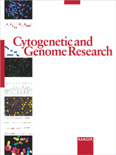
CYTOGENETIC AND GENOME RESEARCH
Scope & Guideline
Unveiling the complexities of genomes and their clinical impact.
Introduction
Aims and Scopes
- Cytogenetic Analysis:
The journal emphasizes the study of chromosome structure, number, and behavior, providing insights into chromosomal abnormalities and their association with various diseases. - Molecular Characterization:
A core focus is on the molecular characterization of genetic materials, including DNA sequencing and genomic mapping, to understand genetic diversity and evolutionary relationships. - Clinical Applications:
Research published often explores the clinical implications of cytogenetic findings, particularly in relation to genetic disorders, cancer, and reproductive health. - Comparative Genomics:
There is a consistent focus on comparative studies across species, which helps in understanding evolutionary processes and genetic variations. - Bioinformatics in Genomics:
Utilization of bioinformatics tools for analyzing genomic data is a key methodology, enabling researchers to interpret complex genetic information effectively.
Trending and Emerging
- Integrative Genomic Approaches:
There is an increasing trend toward integrative genomic studies that combine cytogenetics with molecular biology, emphasizing the importance of understanding genetic functions and interactions. - Radiation Genetics and Biodosimetry:
Research related to the effects of radiation on genetic material and the use of biodosimetry for assessing radiation exposure has gained significant traction, particularly in clinical and environmental contexts. - Epigenetics and Gene Regulation:
Emerging studies focusing on epigenetic modifications and their role in gene regulation and disease manifestation signify a growing interest in understanding complex gene expression mechanisms. - Application of Next-Generation Sequencing (NGS):
The use of NGS technologies for comprehensive genetic analysis is increasingly prevalent, allowing for detailed exploration of genetic variations and their associations with diseases. - Multi-Omics Approaches:
There is a rising interest in utilizing multi-omics strategies, combining genomics, transcriptomics, and proteomics to gain a holistic view of biological systems and their complexities.
Declining or Waning
- Traditional Karyotyping Techniques:
There has been a noticeable reduction in studies solely relying on classical karyotyping methods, as newer genomic techniques such as whole-genome sequencing gain preference for detailed analysis. - Single Organism Studies:
Research focused exclusively on single species or organisms appears to be declining in favor of more integrative approaches that consider comparative genomics across multiple species. - Basic Cytogenetic Techniques:
The publication frequency of papers discussing basic cytogenetic techniques, such as FISH without genomic context, has decreased, reflecting a shift towards more complex, multi-faceted investigations.
Similar Journals

Molecular Genetics & Genomic Medicine
Bridging research and real-world medical solutions.Molecular Genetics & Genomic Medicine, published by WILEY, is an esteemed and open-access journal that has been a prominent source of knowledge in the fields of genetics and molecular biology since its establishment in 2013. With an ISSN of 2324-9269, it aims to provide a platform for the dissemination of novel findings and innovative research that pushes the boundaries of genomics and its clinical applications. The journal holds a Q3 categorization in Genetics, Clinical Genetics, and Molecular Biology, reflecting its growing influence in these disciplines, as evidenced by its Scopus rankings. Researchers, professionals, and students alike will find valuable insights and advancements in genomic medicine, making this journal an essential resource for those dedicated to the understanding and application of genetic and molecular research in healthcare. Located at 111 River St, Hoboken, NJ, Molecular Genetics & Genomic Medicine continues to foster a global dialogue within the scientific community, ensuring accessible knowledge for all.

MAMMALIAN GENOME
Unlocking the secrets of mammalian DNA.MAMMALIAN GENOME is a leading journal in the field of genetics, aimed at advancing our understanding of the genetic makeup and evolutionary relationships of mammals. Published by Springer, this journal has been a cornerstone resource since its inception in 1991, converging extensive research up to 2024. With a commendable Q2 classification in the 2023 Genetics category and a Scopus Rank of #208 out of 347, it serves as a vital platform for sharing cutting-edge findings, methodologies, and reviews pertaining to mammalian genomes. Although not an open-access journal, MAMMALIAN GENOME ensures that its content is accessible through institutional subscriptions, catering to a global audience of researchers, professionals, and students. Its commitment to excellence in genetic research positions it as an essential publication for anyone striving to contribute to this dynamic field.

NUCLEUS-INDIA
Exploring the depths of Genetics and Molecular Medicine.NUCLEUS-INDIA is a prominent academic journal that delves into the intricate realms of Cell Biology, Genetics, Molecular Biology, and Molecular Medicine. Published by SPRINGER INDIA, this journal has been a reliable source of innovative research since its inception in 2011. With an ISSN of 0029-568X and an E-ISSN of 0976-7975, NUCLEUS-INDIA stands out in the scientific community, functioning as a critical platform for the dissemination of groundbreaking findings and advancements within its fields of study. Despite being categorized in the lower quartiles as of 2023, it remains an important contributor to the literature, providing insights that influence both academic and practical perspectives in genetics and molecular sciences. Researchers, professionals, and students alike can benefit from its diverse array of articles addressing contemporary challenges and innovations. The journal is located at 7th Floor, Vijaya Building, 17, Barakhamba Road, New Delhi 110 001, India, and aims to enhance the scholarly discourse in biology by publishing works that push the boundaries of current understanding.

GENETICS AND MOLECULAR BIOLOGY
Empowering researchers to shape the future of biology.GENETICS AND MOLECULAR BIOLOGY, published by the SOC BRASIL GENETICA, is a prominent journal dedicated to the advancement of knowledge in the fields of genetics and molecular biology. Since its inception in 1998, this Open Access journal has served as a vital platform for researchers, professionals, and students to disseminate their findings and engage with the latest innovations and discoveries. With an impact factor that reflects its growing influence, GENETICS AND MOLECULAR BIOLOGY ranks in the Q3 category for both genetics and molecular biology as of 2023, indicating its position within the academic community. The journal is indexed in Scopus, highlighting its commitment to maintaining rigorous peer-review standards while providing wide-reaching access to quality research. Operating out of Ribeirão Preto, Brazil, it fosters a collaborative environment for academic discourse and research development not only in Brazil but also globally. The journal encourages submissions that explore a wide range of topics in genetics and molecular biology, making it an essential resource for anyone involved in these dynamic fields.

Molecular Cytogenetics
Exploring the Intricacies of Cellular and Genetic Interactions.Molecular Cytogenetics is a prestigious open-access journal published by BMC, dedicated to advancing the fields of biochemistry, genetics, and molecular biology. Since its inception in 2008, this journal has facilitated prominent research and developments in the cytogenetics domain, featuring innovative studies and reviews that explore the intricate relationship between cellular structures, genetic makeup, and various biological processes. With a robust impact factor and a commendable positioning within Q3 and Q4 categories across multiple relevant disciplines, it provides a vital platform for researchers to disseminate their findings to a global audience. The journal's open-access model ensures that cutting-edge research is readily available to students, professionals, and scholars, promoting free knowledge exchange. Situated in the vibrant landscape of the United Kingdom, Molecular Cytogenetics continues to contribute significantly to scientific progress, solidifying its role as an essential resource for those engaged in the exploration of genetic and cytogenetic inquiry.

Genetics Research
Illuminating the Path of Genetic UnderstandingGenetics Research, published by HINDAWI LTD, is a distinguished open access journal that has been at the forefront of genetic studies since its inception in 1960. With the transition to open access in 2019, this journal has expanded its accessibility, fostering knowledge dissemination across the global scientific community. Operating out of the United Kingdom, it provides a platform for innovative research in the fields of genetics and molecular biology, encompassing a broad range of topics that are highly relevant to medical sciences. As of 2023, it holds a Q4 classification in Genetics and a Q3 classification in miscellaneous Medicine, reflecting its ongoing commitment to scholarly excellence amidst shifting academic landscapes. While the journal's H-index remains unlisted, its indexed ranking within Scopus, with a rank of #325/328 in the Genetics category highlights the challenges ligated to its niche audience. Nevertheless, it serves as a crucial resource for researchers, professionals, and students eager to contribute to and stay informed on the latest genetic research trends and breakthroughs.

Human Genome Variation
Innovating the Future of Genetic ResearchHuman Genome Variation, published by SpringerNature, is an esteemed open access journal dedicated to the field of genetic research and exploration. Since its inception in 2014, the journal has been at the forefront of advancing our understanding of human genome diversity and its implications in health and disease. With an E-ISSN of 2054-345X, it features a diverse array of studies that encompass biochemistry, genetics, and molecular biology, making it an invaluable resource for researchers and professionals alike. The journal holds a Q3 ranking in both biochemistry and genetics, and a Q4 ranking in molecular biology, highlighting its growing influence within these disciplines. As the landscape of genomics continues to evolve, Human Genome Variation serves as a platform for the dissemination of high-quality research, fostering collaboration and innovation within the scientific community. Researchers and academics are invited to contribute to this pivotal journal, which not only provides open access to its content since 2014 but also aims to bridge the gap between basic research and clinical applications in genetics.

GENOME BIOLOGY
Fostering innovation in genome research and knowledge exchange.GENOME BIOLOGY is a premier, peer-reviewed journal published by BMC, focusing on the rapidly evolving fields of genomics, molecular biology, and bioinformatics. Accessible as an Open Access journal since 2000, it aims to disseminate high-quality, cutting-edge research that contributes to our understanding of genome biology's intricate mechanisms. The journal boasts an impressive impact, ranking 8th in Agricultural and Biological Sciences and 9th in Biochemistry, Genetics and Molecular Biology, highlighting its significance among scholars, professionals, and students alike. With a commitment to facilitating the exchange of invaluable scientific knowledge, GENOME BIOLOGY provides an important platform for discussions on evolutionary biology, genetic systems, and cell biology, contributing to the advancement of these dynamic disciplines.

International Journal of Genomics
Connecting researchers to elevate genomic discourse.International Journal of Genomics is a pivotal open-access publication under the esteemed HINDAWI LTD, dedicated to advancing the fields of genomics, biochemistry, genetics, and molecular biology. Established in 2013, this journal aims to disseminate innovative research findings and foster scholarly dialogue among researchers, professionals, and students alike. With a robust Impact Factor reflective of its commitment to quality, the journal has achieved a Q3 ranking in Biochemistry, Genetics, and Molecular Biology, as well as notable placements in Pharmaceutical Science, indicating its broad relevance and influence in these interconnected fields. The journal is indexed in esteemed databases, ensuring high visibility and accessibility for published works. As an open-access journal, it prioritizes the sharing of knowledge across borders, facilitating greater collaboration and advancement in genomic research globally. Join the academic community in exploring the vast potential of genomics through the International Journal of Genomics, based in Egypt, and reaching audiences worldwide from its London office.

Cold Spring Harbor Molecular Case Studies
Bridging the gap between molecular research and patient care.Cold Spring Harbor Molecular Case Studies is a prestigious journal published by COLD SPRING HARBOR LAB PRESS, PUBLICATIONS DEPT, that has garnered considerable attention in the fields of Biochemistry, Genetics, and Molecular Medicine. With a focus on the intersection of molecular biology and clinical case studies, this journal serves as a key resource for researchers and practitioners seeking to explore novel insights into genetic disorders and biomedical advances. Its impact is underscored by its categorization in Q2 in various disciplines in 2023, reflecting its significance and influence within the academic community. Although currently not labeled as Open Access, Cold Spring Harbor Molecular Case Studies provides a rigorous platform for disseminating high-quality, peer-reviewed research that drives innovation and enhances understanding in these rapidly evolving fields. As a supporter of advancing scientific knowledge, this journal is essential for those dedicated to the exploration of molecular mechanisms and their clinical implications.